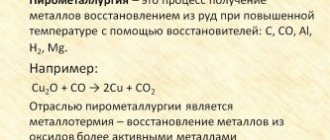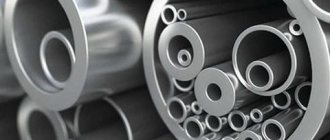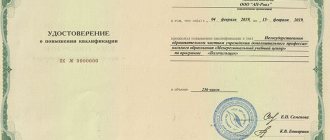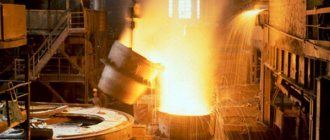Types of raw materials
The very name “colored” means the color of the metal. Some types, such as copper, have a distinct color tint. Such substances are important because of their properties and qualities, which are much different from ordinary iron.
Therefore, the production of non-ferrous metals and alloys is necessary to obtain qualitatively new compounds used in all industries.
An alloy is a mixture of metals. When two or more metals in a molten state are combined, a new material is formed that has almost the full range of properties possessed by the constituents of the alloy.
Non-ferrous metals are divided into several large groups:
- Heavy - this group includes copper, zinc, lead, tin.
- Lungs - this group is represented by magnesium, titanium, beryllium, calcium, strontium, aluminum, sodium, potassium, cesium.
- Noble - are the most expensive of non-ferrous metals, which are scarce in nature: platinum, gold, silver, osmium, ruthenium, rhodium, palladium.
- Minor substances are a group of substances that are also rare in nature. These include cobalt, cadmium, antimony, bismuth, and mercury.
- Refractory: manganese, tungsten, chromium, vanadium, tantalum.
- Rare earths.
- Absent-minded.
- Radioactive.
Industry Composition
Types of non-ferrous metallurgy include industries related to the production of certain types of metals. Thus, the following sectors can be distinguished in aggregate:
- copper production;
- aluminum production;
- production of nickel and cobalt;
- tin production;
- lead and zinc production;
- gold mining.
The production of nickel is closely related to the place of extraction of nickel ores, which are located on the Kola Peninsula and in the Norilsk region of Siberia. Many branches of non-ferrous metallurgy are distinguished by multi-stage metallurgical processing of intermediate products.
Non-ferrous metals
On this basis, an integrated approach is effective. This is a raw material for the production of other related metals. Waste recycling is accompanied by the production of materials used not only in other branches of heavy engineering, but also in the chemical and construction industries.
Process Features
In industry, non-ferrous metals in their pure form are practically not used, but rather alloys are used, which makes it possible to achieve the required properties. During the production of non-ferrous metals, their chemical, physical and mechanical properties are modified, which is very important for the manufacture of both household and industrial items.
A special feature of non-ferrous metals is their ease of processing. Almost all of them are ground, forged, stamped, pressed, cut, welded or soldered.
During production from these substances it is possible to obtain not only finished products, but also a variety of semi-finished products:
- rods;
- wire;
- powder;
- foil.
Production of non-ferrous metal wire
Lead
Lead has been known since ancient times - at least two millennia BC. e. At that time, the easy machinability of soft lead and its high density were especially valued. Coins, jewelry, various vessels, water pipes, projectiles for slings and catapults were made from lead. With the invention of gunpowder, lead was used to make buckshot, bullets and shot.
Lead's resistance to dilute sulfuric and hydrochloric acids and many other reagents made this metal a popular choice in the 19th century. the main material of the then emerging chemical industry. Lead is easily rolled. Sheet (rolled) lead with a thickness of 2 to 10 mm is convenient for covering equipment and protecting it from corrosion.
The sheaths of cables intended for long-term operation underground, in water or in a humid atmosphere are now made from lead, adding small amounts of other metals to it for greater ductility.
Lead-acid batteries are still needed to ignite internal combustion engines, despite the advent of nickel batteries, which are significantly more expensive. About half of all lead is spent on the production of cables and batteries.
In nuclear technology, lead serves as protection against γ rays, which it absorbs better than many other materials.
In military affairs, lead is still needed for the manufacture of shrapnel and core bullets.
Lead alloys differ from pure metal either in greater strength and hardness, or in anti-friction; Most of them are also resistant to corrosion.
Alloys with a low coefficient of friction - babbitts (after the name of the inventor Babbitt) - are divided into tin-bearing and tin-free. The former contain, in addition to lead, tin, copper, antimony, cadmium, nickel and tellurium, and the latter contain sodium, calcium, tellurium and other elements. Babbitts are low-melting, they are poured in liquid form into bearing shells or applied as a layer on a steel strip.
Typographic alloys for casting fonts contain, in addition to lead, antimony, tin and copper. Antimony gives them hardness, and tin gives them casting qualities.
In the chemical industry, alloys of lead and antimony are often used - they are hard and resistant to corrosion.
In alloys for soldering - solders, lead is partially replaced by more expensive and scarce tin.
Demand for lead constantly outstrips its production. Therefore, in modern industry, new ways to save lead are being outlined. They are now trying to replace the lead sheaths of some cables with plastic ones, and anti-corrosion coatings with synthetic organic materials. Printing lead alloys can sometimes be replaced with zinc alloys, and in the future - with plastics, when plastics with good casting properties are obtained.
Production methods
For the production of non-ferrous metals and alloys, a variety of methods are used, based on the chemical properties of the base from which the metal or alloy will be obtained and the reagent.
Pyrometallurgy is a method of producing non-ferrous metals by selective smelting, which can be oxidative or reduction. The source of heat and the main reagent is most often the sulfur present in the ore.
Electrolysis is a method based on the chemical reaction of electrolysis. A cathode and anode are used. At the cathode, which is a bath of refractory material, metal ions are deposited as a result of dissociation. The reaction, unlike the traditional one described in chemistry textbooks, is carried out not in an aqueous environment, but in a melt. This is due to the need to avoid the deposition of hydrogen ions on the cathode, which does not allow the isolation of pure metal.
Metallothermy is a method of reducing metal chlorides or oxides under the influence of another substance. The technology is mainly used in the production of titanium. At the same time, magnesium is extracted, since magnesium chloride is a by-product.
Alloying - This method involves directly mixing two metals. Additionally, a charge or alloying material is supplied in a liquid state. This method is one of the most productive, less expensive and allows you to obtain uncontaminated metals with specified physical and chemical properties.
Metal casting
Industry specifics
Non-ferrous metal ores, as mentioned above, contain a small amount of the mined element. Therefore, for a ton of the same copper, up to 100 tons of ore are needed. Due to the large demand for raw materials, non-ferrous metallurgy is, for the most part, located close to its raw material base.
Non-ferrous ores require large amounts of fuel or electricity for their processing. Energy costs reach half of the total costs associated with smelting 1 ton of metal. In this regard, metallurgical enterprises are located in close proximity to electricity producers.
The production of rare metals is mainly based on reduction from compounds. Raw materials come from intermediate stages of ore beneficiation. Due to the small volumes and difficulty of production, laboratories are engaged in obtaining rare metals.
Production of certain types
Copper production
This non-ferrous metal is obtained from copper ores. Its content in these compounds ranges from 1 to 6%. With a copper composition of less than 1%, its extraction at the current level of technology development does not seem to be profitable.
Copper is obtained in two ways:
- hydrometallurgical;
- pyrometallurgical.
The first method is less common, since when using it it is not possible to extract other elements from the ore.
The pyrometallurgical copper mining method consists of several successive stages:
- Preparing ore for smelting through beneficiation and further roasting. This allows you to obtain a copper concentrate.
- Subsequent roasting is required to reduce the amount of sulfur.
- Melting for matte. By smelting copper concentrates it is possible to obtain matte or sulfides of copper and iron.
Matte conversion is also carried out. This stage consists of blowing air inside a special copper smelting converter onto the resulting matte, which allows the iron to be separated into slag and obtain blister copper.
And finally - refining. Blister copper is subjected to fire melting and electrolytic refining, which ultimately results in a product whose purity is 99.97–99.99%.
Aluminum production
Aluminum is produced by the electrolysis of alumina. The process includes several stages.
Obtaining pure alumina or aluminum oxide. This process involves treating bauxite (ores containing metal) with alkaline solutions. The result is the precipitation of aluminum hydroxide.
Preparation of cryolite - its production consists of processing fluorspar to obtain hydrofluoric acid and further release of fluoroaluminum acid. By means of soda, cryolite is released in the form of sediment.
Electrolysis of alumina - the result of this process is the production of raw aluminum.
Refining – by blowing molten raw material with chlorine, pure aluminum is extracted.
Magnesium production
Magnesium is extracted through an electrolysis reaction. The raw materials are molten metal salts (carnallite, magnesite, dolomite, bischofite). The electrolyte is based on magnesium chloride. Additionally, sodium chloride, calcium and potassium are used.
After the reaction, a rough metal containing up to 5% impurities settles on the anode. Their removal occurs through a refining process using fluxes. All non-metallic components are converted into slag, and pure metal is poured into molds.
Titanium production
Titanium and its alloys are superior in quality to alloy steels. The titanium production process is hampered by its increased activity, especially as temperatures rise.
Its peculiarity is the ability to react with many metals, which requires compliance with certain conditions to obtain pure titanium.
The method used to obtain titanium is called magnetothermy. It consists of the following operations.
Isolation of titanium concentrate by beneficiation of ore containing such metal.
Slag production - at this stage, the separation of iron oxides from titanium oxides occurs.
Obtaining titanium tetrachloride - to obtain titanium metal, the use of titanium chloride is required, obtained by chlorinating slag.
Reduction through magnesium - the reduction process takes place at very high temperatures - close to 1 thousand degrees. A reactor where magnesium is melted and titanium vapor is supplied. During metallization, it settles on the walls, and molten magnesium is removed through a tap hole.
Separation of the mass in a vacuum - the titanium obtained as a result of the previous step in the form of a sponge mass must be heated using a vacuum, which will allow the separation of pure metal.
Features of raw materials
All non-ferrous metals have a number of characteristics that must be taken into account when processing or using them.
A number of elements have increased thermal conductivity and specific heat capacity:
- copper;
- magnesium;
- aluminum.
When welding, the joint quickly cools, which will require the use of powerful sources, especially heat during welding.
Some elements change their mechanical properties when suddenly heated. Their decline is observed. At the same time, the metal itself becomes easily destroyed by impacts or other mechanical impacts.
All non-ferrous metals easily interact with gases, except inert ones. This feature is typical for refractory non-ferrous metals.
Metallurgy of light metals
The most common light metal is aluminum. Alloys based on it have properties inherent in structural and special steels.
To obtain aluminum, the raw materials are bauxite, alunite, and nepheline. Production is divided into two stages:
- At the first stage, alumina is obtained and a large volume of raw materials is required.
- In the second stage, aluminum is produced using the electrolytic method, which requires inexpensive energy. Therefore, the production stages are located in different territories.
The production of aluminum and alloys is concentrated in industrial centers. Scrap is also supplied here for recycling, which ultimately reduces the cost of the finished product.










